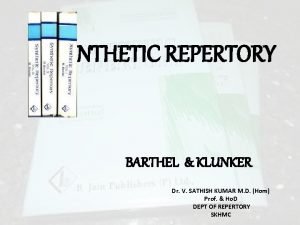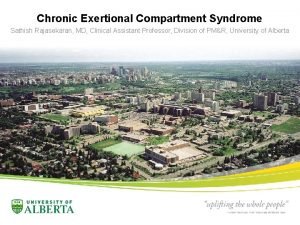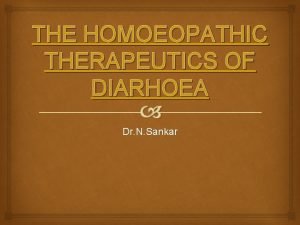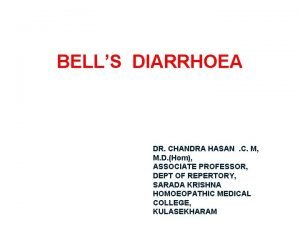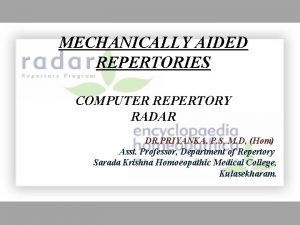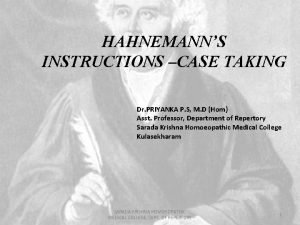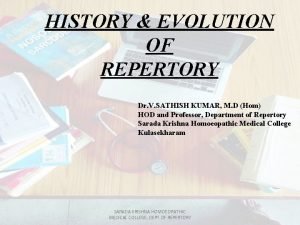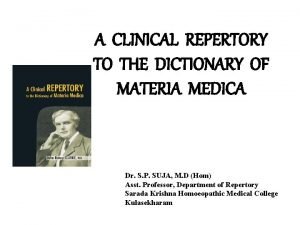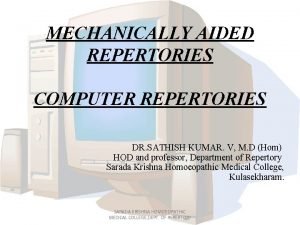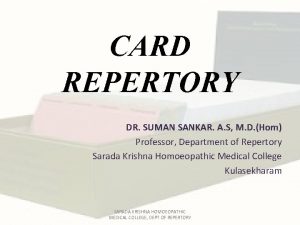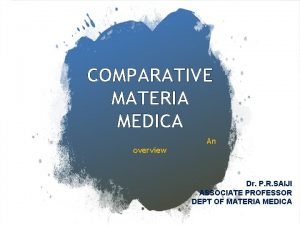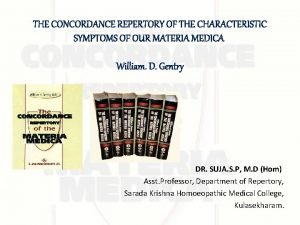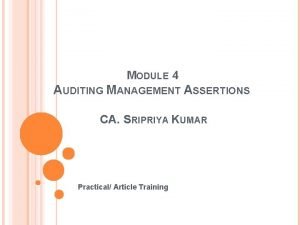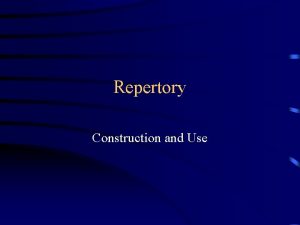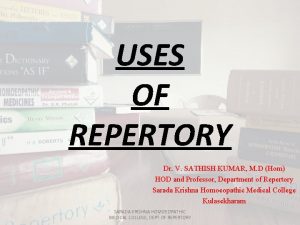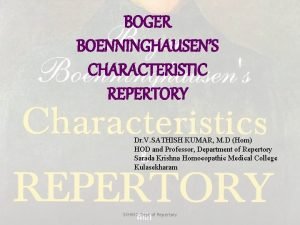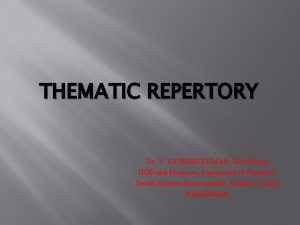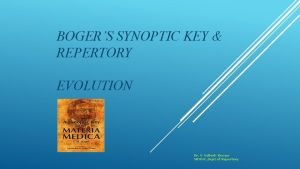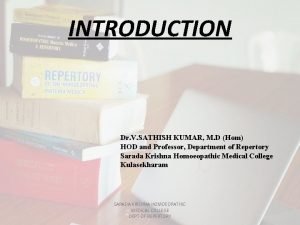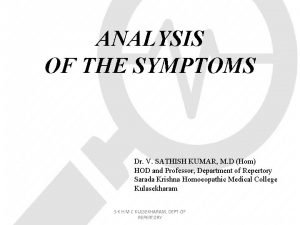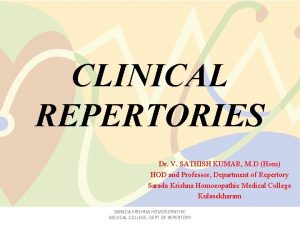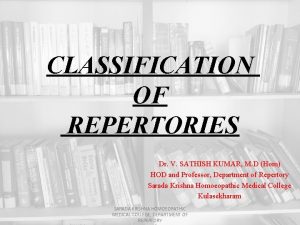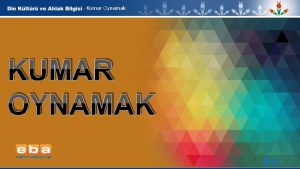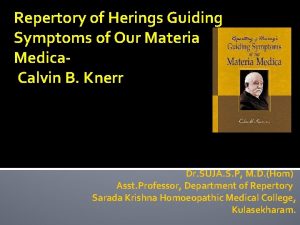USES OF REPERTORY Dr V SATHISH KUMAR M






















- Slides: 22

USES OF REPERTORY Dr. V. SATHISH KUMAR, M. D (Hom) HOD and Professor, Department of Repertory Sarada Krishna Homoeopathic Medical College Kulasekharam SARADA KRISHNA HOMOEOPATHIC MEDICAL COLLEGE, DEPT OF REPERTORY

Uses of Repertory • • To find out the similimum As reference book It helps us to study of Materia Medica Helps to find out a complete symptom It helps in formulating questions. Its constant use makes a physicians efficient. It suggests related remedies, which could be helpful for selecting a drug for a second prescription. SARADA KRISHNA HOMOEOPATHIC MEDICAL COLLEGE, DEPT OF REPERTORY

Uses (Contd. . ) • The study of sub-rubric will help us to formulate questions to complete the disease picture. • For a pathological prescription if nothing is available, the remedies present in that rubrics can be differentiated and given. • In a one-sided disease, depending upon the presenting symptomatology, repertorisation can be done and a prescription given. SARADA KRISHNA HOMOEOPATHIC MEDICAL COLLEGE, DEPT OF REPERTORY

Uses (Contd…) • Reference to repertory will show the remedies for the referred condition that the physician may not have thought of. • It helps to refresh memory for particular symptoms. SARADA KRISHNA HOMOEOPATHIC MEDICAL COLLEGE, DEPT OF REPERTORY

Uses (Contd…) • The quest for compiling an updated repertory has not only given birth to many repertories, but also to authentic repertories. Modern repertories can also be considered as sources of information. • Through the references and ‘cross – reference’ one can know the similar rubrics. Thus repertories help us to select the right rubric among similar rubrics. SARADA KRISHNA HOMOEOPATHIC MEDICAL COLLEGE, DEPT OF REPERTORY

Uses (Contd…) • Addition of a number of medicines, clinical rubrics and pathological generals helps in the study of homoeopathy in relation to modern pathology. • With introduction of the computer in repertory, it has become an invaluable companion, both for clinicians and Academicians. It helps in a speedy retrieval of the known facts. SARADA KRISHNA HOMOEOPATHIC MEDICAL COLLEGE, DEPT OF REPERTORY

WHERE TO USE THE REPERTORY • Cases where several remedies seem to cover the picture • Mismanaged cases • Cases where do not show clear picture and related group of remedies • To trace out probable sequence of remedies that may be necessary to cure. • To differentiate between seemingly indicated remedies. • To work out relationship of remedies and second prescription. SARADA KRISHNA HOMOEOPATHIC MEDICAL COLLEGE, DEPT OF REPERTORY

WHERE NOT TO USE • In those cases where there are clear indication of simillimum. SARADA KRISHNA HOMOEOPATHIC MEDICAL COLLEGE, DEPT OF REPERTORY

LIMITATIONS OF REPERTORY • It is a means to an end, never an end in itself. • Each one has its own scope and limitations. one should be thorough with all types of repertories in order to get the best out of them. • New additions to Materia Medica cannot be accommodated in repertories on a day to day basis. Hence, they cannot always keep pace with the latest in Materia Medica. SARADA KRISHNA HOMOEOPATHIC MEDICAL COLLEGE, DEPT OF REPERTORY

LIMITATIONS (Contd. . ) • There are many rubrics, which are not represented well. Therefore, they cannot guide a physician properly in the selection of a simillimum. • If the physician makes a mistake at the beginning , by ignoring the person and just counting the symptoms and marks, then using a repertory will be futile. SARADA KRISHNA HOMOEOPATHIC MEDICAL COLLEGE, DEPT OF REPERTORY

LIMITATIONS (Contd. . ) • The repertory cannot give guidance regarding the potency, doses and repetition schedule. • Nosodes are not represented properly in any repertory. • Handling and use of repertory cannot be independent of the knowledge in Materia Medica , Organon or clinical subjects , as well as knowledge of human behaviour. SARADA KRISHNA HOMOEOPATHIC MEDICAL COLLEGE, DEPT OF REPERTORY

LIMITATIONS (Contd. . ) • Each repertory has its own gradation of remedies. One must master how the gradations are given in each repertory. • Gradation varies under similar rubrics in different repertories. • Very few latest repertories show the source of each remedy. • There are many similar rubrics in one repertory, which are difficult to differentiate from each other. SARADA KRISHNA HOMOEOPATHIC MEDICAL COLLEGE, DEPT OF REPERTORY

LIMITATIONS (Contd. . ) • Similar rubrics in different repertories consist of different remedies. • Family history or past history are not well presented in the repertories. • A lot of misplaced rubrics can be seen in different sections of repertory. SARADA KRISHNA HOMOEOPATHIC MEDICAL COLLEGE, DEPT OF REPERTORY

TERMINOLOGIES SARADA KRISHNA HOMOEOPATHIC MEDICAL COLLEGE, DEPT OF REPERTORY

RUBRICS : The word rubric originated from Latin word “rubrica”. It means a heading , a guiding rule. In repertory rubrics are the headings and subheadings which list a group of drugs or a drug. These headings are the converted form of the symptoms of a patient or drugs, thus a rubric is the repertorial language of representing symptom. General rubric Similar rubrics Pathological rubric Eliminating rubric Sub-rubric Particular rubric Clinical rubric Cross-reference SARADA KRISHNA HOMOEOPATHIC MEDICAL COLLEGE, DEPT OF REPERTORY

• General rubrics: - These are the main rubrics / main headings under different chapters. They are mentioned as side headings and usually contain a larger number of medicines. They are also called super rubrics. • Sub-rubrics: - These are the further divisions of rubrics. Commonly they are mentioned below the general rubrics. Usually they qualify or modify the general rubrics. SARADA KRISHNA HOMOEOPATHIC MEDICAL COLLEGE, DEPT OF REPERTORY

• Similar rubric: - Those rubrics which resembles or correspond in meaning. • Particular rubrics: - Rubrics related to the parts or organ are called particular rubric. • Pathological rubrics: - Rubrics which represents some pathological changes or conditions are called pathological rubrics like – inflammation SARADA KRISHNA HOMOEOPATHIC MEDICAL COLLEGE, DEPT OF REPERTORY

• Clinical rubrics: Rubrics related to disease conditions are called clinical rubrics. Eg. Addision’s disease, anemia etc. • Eliminating rubrics: - It is the rubric which is used for elimination of apparently similar medicines in order to select the simillimum. SARADA KRISHNA HOMOEOPATHIC MEDICAL COLLEGE, DEPT OF REPERTORY

CROSS-REFERENCES: • It means a reference made from one part of a book, register etc. to another part where the same word or subject is treated of. • In repertory, cross- references means the referring of similar rubrics either to compare or to enhance the knowledge of a group of medicines. SARADA KRISHNA HOMOEOPATHIC MEDICAL COLLEGE, DEPT OF REPERTORY

CROSS-REFERENCES (Contd…): They are two types: 1. The main rubric contain a synonym in the bracket without giving any medicines against it. 2. The main rubric contain some terms, which are similar in meaning. Such rubrics also contain a group of medicines. SARADA KRISHNA HOMOEOPATHIC MEDICAL COLLEGE, DEPT OF REPERTORY

References • A reference to repertories for homoeopathic students-DR. SIJU. P. V • Essentials of repertorisation-DR. SHASHI KANT TIWARI SARADA KRISHNA HOMOEOPATHIC MEDICAL COLLEGE DEPT OF REPERTORY

SARADA KRISHNA HOMOEOPATHIC MEDICAL COLLEGE DEPT OF REPERTORY
 Dr sathish rajasekaran
Dr sathish rajasekaran Musculoskeletal surgery ayr
Musculoskeletal surgery ayr Sathish rajasekaran
Sathish rajasekaran Bell's diarrhoea repertory
Bell's diarrhoea repertory Bell's diarrhoea repertory
Bell's diarrhoea repertory Pathological generals in repertory
Pathological generals in repertory Btpb repertory
Btpb repertory Mechanical aided repertory
Mechanical aided repertory Conjoint malady in repertory
Conjoint malady in repertory History and evolution of repertory ppt
History and evolution of repertory ppt Rubric definition in repertory
Rubric definition in repertory Computer repertory
Computer repertory Conjoint malady in repertory
Conjoint malady in repertory Card repertory
Card repertory Potential differential field in repertory
Potential differential field in repertory Post kentian repertory
Post kentian repertory Boger boenninghausen characteristic repertory
Boger boenninghausen characteristic repertory Gentry repertory
Gentry repertory Management assertions
Management assertions Kumar kom jet
Kumar kom jet Tan steinbach kumar
Tan steinbach kumar Vikas kumar
Vikas kumar Dr pulin gupta
Dr pulin gupta
